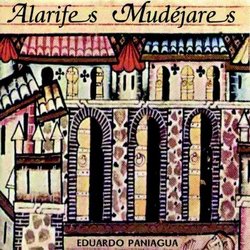| All Artists: Eduardo Paniagua Title: Alarifes Mudéjares Members Wishing: 0 Total Copies: 0 Label: Karon Release Date: 11/16/1999 Album Type: Import Genres: Dance & Electronic, International Music Style: World Dance Number of Discs: 1 SwapaCD Credits: 1 UPC: 8428353017018 |
Search - Eduardo Paniagua :: Alarifes Mudéjares
 | Eduardo Paniagua Alarifes Mudéjares Genres: Dance & Electronic, International Music
|
Larger Image |
CD Details |
CD ReviewsA gorgeous journey back through time... Veggiechiliqueen | 10/04/2004 (5 out of 5 stars) "While living in northern Spain (Burgos, Castilla y León), I travelled to Cuéllar. Part of my trip involved visiting the castle and Mudéjar church of St. Martín de Cuéllar (built in the 12th century). Inside the church, we participated in a multimedia journey through the church's construction by Jewish, Christian and Moorish craftsmen during the Convivéncia, the period of time when the three religions coexisted peacefully in Spain. This CD is the soundtrack to the multimedia exhibit, and stands alone well, recorded between 1995-1999. The composer, Eduardo Paniagua, is also a talented multi-instrumentalist, playing psaltery, flutes, cymbals, drums and effects.
A brief note: as the majority of Spain was under Moorish control from 711-1492 AD, Islamic poetry, artwork and music greatly influenced Spanish culture. The word "mudéjar" refers to Muslims who lived and worked in northern Spain's Christian society. An alarife was an architect. Mudéjar architecture is characterized by ornate plasterwork in geometric designs, repeating arches, and the extensive use of brick. Each track covers a specific theme regarding the construction, including pillars, arches, and vaults, plasterwork, the atrium, bricklaying, tile laying, etc. Arabic instruments (derbuka, oud, dulcimer, nay, a muezzin chanting) are interspersed with nature sounds (frogs, crickets, fountains, water). On the haunting "La Alfombra," sacred chants from the three traditions (Gregorian chant, Judaic ceremonial chant, and Islamic chant) are fused. There is even an appearance from the Cantiga of Alfonso X El Sabio (Fiesta de Santa María). I will never forget "Las Velas: De pronto se llenó"--at that point in the exhibit, we each took a candle and lit a grid of candles in the floor one by one, accompanied by the waltzing, Celtic rhythms of flute, tinkling bells, and dulcimer as the candle flames danced. The CD case and liner notes are gorgeous and well-documented, including bilingual (Spanish/English) history for each track, a brief history of Mudéjar art and medieval Spanish history, the religious background of La Convivéncia, and more. The artwork is reproduced from miniatures from Alfonso X's "Cantigas de Santa María", photos of San Martín, Mudéjar tapestries and plasterwork, and conceptual sketches of the church's interpretation centre. Not strictly a historical recording of Mudéjar music (of which there are many, both in Spain and abroad, although fewer in number), but a fascinating interpretation of an important moment in Spanish history, as well as a beautiful collaboration of Islamic, Jewish and Christian medieval sacred music. (More information on the town of Cuéllar (a bastion of Mudéjar architecture and the home of the Church of San Martín, for which this music was composed), can be found at www.aytocuellar.es) " |

 Track Listings (13) - Disc #1
Track Listings (13) - Disc #1